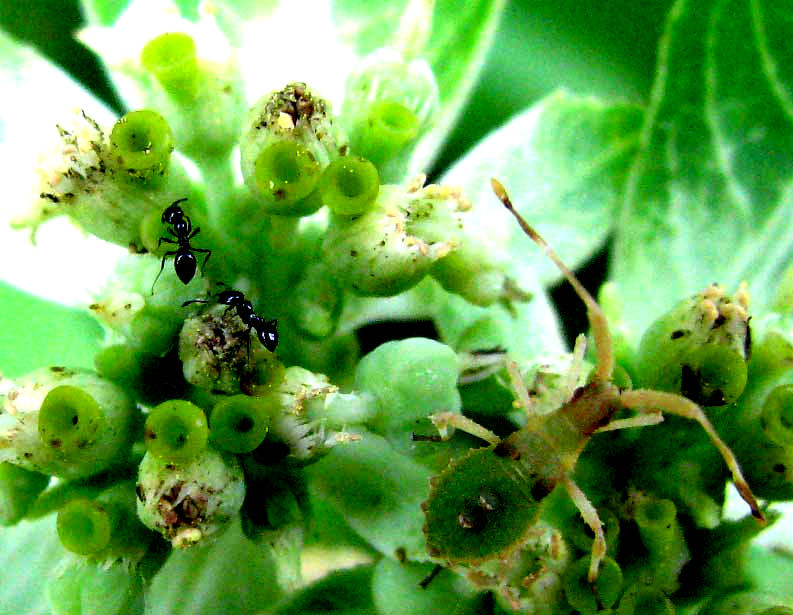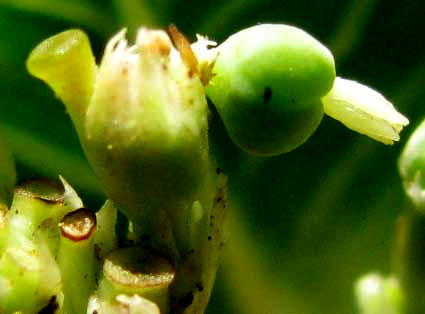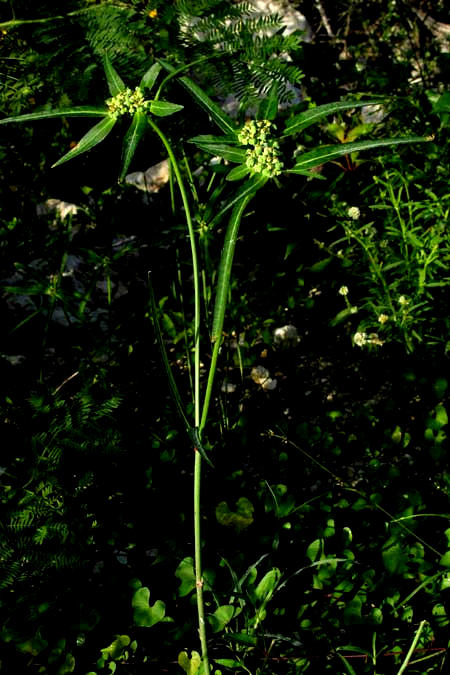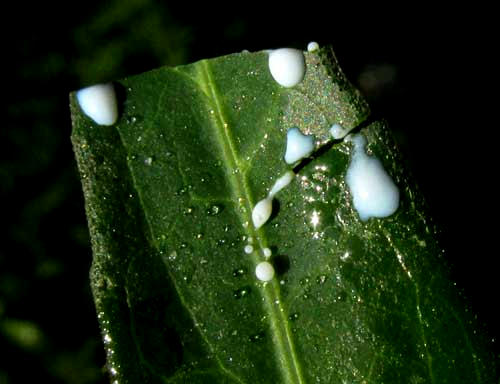Excerpts from Jim Conrad's
Naturalist Newsletter

from the June 27, 2010 Newsletter issued from Hacienda Chichen Resort beside Chichén Itzá Ruins, central Yucatán, MÉXICO; limestone bedrock, elevation ~39m (~128ft), ~N20.676°, ~W88.569°
WILD POINSETTIA
Christmas Poinsettia's technical name is Euphorbia pulcherrima. A very common, knee-high herb presently flowering here now, often as a weed along roadsides, is the closely related EUPHORBIA HETEROPHYLLA, which goes by several English names, especially Wild Poinsettia, Mexican Fireplant, Painted Euphorbia, Fire on the Mountain and Paint Leaf. You can see it above.
Maybe you notice similarities between this plant and the Christmas Poinsettia, especially in the similar leaf shape, how the leaves cluster at the stem's top, and how the cluster's middle leaves are colored toward their bases. Of course Christmas Poinsettias are red where the plant in the picture is white. However, this is a very variable species and sometimes the leaf bases are red.
A close-up of the flowers at the cluster's center is shown below:

Using the black ants for scale (and they're small ants) you can see that we're seeing things at very close range. And the "flowers" are classic Euphorbia "flowers," which means that their structure is surreal.
First, the green doughnut thingies. Notice that some of them are glistening, and that an ant appears to be feeding at one. The glistening substance is nectar, so the green doughnuts are nectar glands exuding nectar the ants like. One guesses that the ants, in return for the nectar, protect the plant from herbivores who may come nibbling. And that white and green nymph at the lower right -- who knows how it fits in?
Each green nectar gland is associated with one urn- shaped structure peculiar to Euphorbia and closely related genera. The urn-shaped thing, which is about 1/8th inch across (2.5 mm) is called a cyathium. Cyathia are not flowers, but rather clusters of flowers, almost as seen among composite flowers in the Composite Family. A single cyathium is shown below:

Three main items are visible in that picture. The whitish, flowerlike, urn-shaped cyathium lies a little to the picture's left. A yellow-green nectar gland arises on the cyathium's left. Unseen inside the cyathium reside a few -- five or so -- unisexual male flowers that are so streamlined or reduced that they consist of no more than one stamen arising from its pedicel, the pedicel being a flower's stem.
The green, spherical item to the cyathium's right is the female flower, which consists of the green ovary atop a slender pedicel anchored at the cyathium's bottom inside. In other words, the cyathium's single female flower hangs outside the cyathium. There's not enough room for it inside. The white, elongate things at the green ovary's right are style segments with stigmatic areas on which pollen grains germinate.
All Euphorbia flowers are structured more or less in the same way, in cyathia, though the cyathium of each species is a little different from the cyathium of every other species -- and worldwide over 1000 Euphorbia species are recognized, so just think about it. In 2006 we met another flowering "Wild Poinsettia," a Euphorbia, Euphorbia cyathophora, so you can see how that differs from this species at www.backyardnature.net/yucatan/poinsett.htm.
Our current Wild Poinsettia is native from California to eastern Texas through Mexico and into much of Central America. As an invasive weed it's spread to South and Southeast Asia, where in India and Thailand it invades cotton fields and other disturbed environments.
from the August 28, 2016 Newsletter issued from Hacienda Chichen Resort beside Chichén Itzá Ruins, central Yucatán MÉXICO
WILD POINSETTIA, NARROW-LEAFED FORM
The species is named "heterophylla" because its leaves can vary wildly -- they're "heterogeneous" in appearance. The above entry shows the local form with broad leaves. This week, growing atop thin soil on limestone bedrock, along a trail through the woods, some slender-leafed plants turned up, looking like completely different species from what we've seen earlier, shown below:

The leaves are radically different in appearance, but the flowers -- much more important in determining a plant's identification -- are the same. Below, you can see the weird flower structure, which is absolutely typical of the genus Euphorbia, on this week's plant:

That picture shows cuplike "cyathia" from which plump, three-lobed ovaries dangle on curved stipes. Peeking from the topmost cyathium area couple of tan-colored anthers; Several unisexual male flowers reside inside the cyathium. Attached to the outside wall of each cyathium there's something looking like a green golf tee. Those are nectaries. This floral construction looks like something a daydreaming kid would fit together from spare parts, but it must be effective, for the genus Euphorbium is a big one found worldwide, and all species display this same basic configuration.
One other feature of euphorbia is that when injured their leaves "bleed" a white, milky latex rich in compounds that often are toxic, as shown below:

Euphorbia heterophylla is native from California to eastern Texas south through Mexico into much of Central America. As an invasive weed it's spread to South and Southeast Asia, where in India and Thailand it invades cotton fields and other disturbed environments.